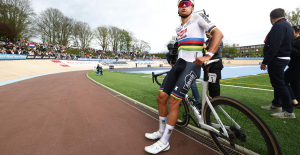It is not easy to find the sculptures of Narcissus, the youth who fell in love with one's own mirror image. Albert Lutz, the Director of the Museum Rietberg, in any case, at the equipment of its new exhibition neither in the ancient nor in the Renaissance find, however, in the Royal Academy of London. There he discovered the wonderful, almost sweet sculpture of "Narcissus", by the British sculptor John Gibson, 1838, created from white marble.
Now, naked boy, with a forward bent face that is going to be to look at image in a pond is part of Gibson's, "welcoming Committee" of the exhibition "mirror of The man in the reflection" in the Museum Rietberg . In the first room, there is also Bill viola's "Surrender"Video from the year 2001 to see the shows two actors in a sea of tears. Then of Giovanni Segantini paintings "repetitive things" (1897), the observed a naked red-haired beauty in a mountain lake instead of your mirror image of a hideous snake among you. Finally, a wonderful miniature from "Roman de la rose" from the middle of the 14. A century earlier, in the face of a in a garden a man in a fountain is mirrored.
Director Albert Lutz is going to retire soon and is inviting with this wide-ranging exhibition of his farewell performance. After twenty years at the helm of the Museum Rietberg, it has become a kind of retrospective of the past years, as many of the topics alluded to in previous exhibitions or explicitly be resumed. On this aspect of the huge rear-view mirror of Silvie takes Fleury, which is situated at the entrance of the exhibition.
to
The Show presents the sum of the experiences that has Lutz as an exhibition-maker. Because the "mirror"is a particularly lush, associative and very varied parting gift, which is likely to bring with stunning works on loan from the Louvre, the Victoria and Albert Museum and the Metropolitan Museum, the most spoiled visitors to the shoals.
mirror box with women, 4. Century. BC photo: RMN-Grand Palais (Musée du Louvre)
At the beginning of the exhibition in numerous images and texts, the time of the mirror as a means of self-knowledge. At 18 months, infants are able to recognize themselves in a mirror. The own image in the mirror, then, is essential to the development of the Self and is not being replaced, but supplemented by the Selfie. This is mentioned in the exhibition a number of times and positively implemented, to the extent that the visitors are encouraged to Make use of Selfies.
After that, the trip goes through the 7000 years of cultural history, to the everyday object level. The oldest specimens are grave goods of Obsidian found in Neolithic graves in Anatolia.
Toxic mercury vapors
It strips almost all of the eras and continents and reaches all the way to the contemporary art is represented, among others, the Work of numerous photographers and the works of Anish Kapoor, Gerhard Richter and Michelangelo Pistoletto. Great also the enigmatic woman who has made the Belgian painter Paul Delvaux in a cave. The mirror is not to be used in "The woman in the mirror" from 1936 degree of self-knowledge, but doubled (and thus intensifying) the empty look of the front of hinstarre woman.
The trip around the world from Egypt, Rome and the Celts, to India, to Indonesia, China, and Japan, and then to Peru and Mexico in North America. Aesthetically extremely appealing, because the levels were, in most cultures, a luxury item and artfully decorated. At the same time also an introduction to the technology of mirror manufacture takes place on this trip. While you are polished in the early period of the cultural history of the mirror stones such as Obsidian for so long, until they began to reflect, came, later, metals such as copper and Bronze.
The Show with their magnificent loans the farewell gift to the Director, who has retired.
In the middle ages, were poured in glass vessels with lead, so that the hemispherical mirror developed. In the 17th century. Century, then came mercury, with the mirror walls in Versailles to Shine. The fumes of the poison to be brought in but the workers in the workshops in Paris and Picardy, at a young age. Only with the German chemist Justus Liebig, who discovered a technology for toxin-free coating of glass with silver, was the level of production in the second half of the 19th century. Century revolutionized. Today, mirrors are usually made with aluminum.
So much chronology in this exhibition, plays a role in the structure of twelve rooms, most of which are located in the second basement of the Adolf Krischanitz-built building, is of a thematic nature. It takes you from the self-portrait of virtuous and magical mirror to the instruments of voyeurism and the means to access in parallel worlds. As seen in the case of Pistoletto or even widely known in Lewis Carroll's "Alice in Wonderland", where the girl passes through a mirror and into a world of dreams.
Because the mirror is an ambivalence that makes him quite the truth, but always aware of the power that it has to do with a transitory and yet to be side-inverted image. At Ovid, Narcissus had to experience that he could fall in love with your own mirror image, which he discovered on the surface of the water of a source, that he became but given the Unerfüllbarkeit of his desire immediately into a flower, a Narcissus,.
brutality in the bathroom
Particularly pretty and particularly currently, the final image has found Lutz for his exhibition. It's called "Swiss Narcissus" and comes from the Basel artist Paul Camenisch, painted it in 1944 as a comment to Swiss neutrality. The painting shows a naked young man in the bathroom, as he considered undisturbed, and a little bit of yourself in the mirror, was after the battle of Stalingrad. While the Swiss narcissist is focused on his appearance, the tiles on the wall, where Camenisch with red and green pen shooting scenes held firmly in an almost surrealistic way, the whole brutality of the war into the bathroom.
17. May to 22. September, 2019.
(editing Tamedia)
Created: 15.05.2019, 20:38 PM

 After 13 years of mission and seven successive leaders, the UN at an impasse in Libya
After 13 years of mission and seven successive leaders, the UN at an impasse in Libya Germany: search of AfD headquarters in Lower Saxony, amid accusations of embezzlement
Germany: search of AfD headquarters in Lower Saxony, amid accusations of embezzlement Faced with Iran, Israel plays appeasement and continues its shadow war
Faced with Iran, Israel plays appeasement and continues its shadow war Iran-Israel conflict: what we know about the events of the night after the explosions in Isfahan
Iran-Israel conflict: what we know about the events of the night after the explosions in Isfahan Sánchez condemns Iran's attack on Israel and calls for "containment" to avoid an escalation
Sánchez condemns Iran's attack on Israel and calls for "containment" to avoid an escalation China's GDP grows 5.3% in the first quarter, more than expected
China's GDP grows 5.3% in the first quarter, more than expected Alert on the return of whooping cough, a dangerous respiratory infection for babies
Alert on the return of whooping cough, a dangerous respiratory infection for babies Can relaxation, sophrology and meditation help with insomnia?
Can relaxation, sophrology and meditation help with insomnia? Vacation departures and returns: with the first crossovers, heavy traffic is expected this weekend
Vacation departures and returns: with the first crossovers, heavy traffic is expected this weekend “Têtu”, “Ideat”, “The Good Life”… The magazines of the I/O Media group resold to several buyers
“Têtu”, “Ideat”, “The Good Life”… The magazines of the I/O Media group resold to several buyers The A13 motorway closed in both directions for an “indefinite period” between Paris and Normandy
The A13 motorway closed in both directions for an “indefinite period” between Paris and Normandy The commitment to reduce taxes of 2 billion euros for households “will be kept”, assures Gabriel Attal
The commitment to reduce taxes of 2 billion euros for households “will be kept”, assures Gabriel Attal The exclusive Vespa that pays tribute to 140 years of Piaggio
The exclusive Vespa that pays tribute to 140 years of Piaggio Kingdom of the great maxi scooters: few and Kymco wants the crown of the Yamaha TMax
Kingdom of the great maxi scooters: few and Kymco wants the crown of the Yamaha TMax A complaint filed against Kanye West, accused of hitting an individual who had just attacked his wife
A complaint filed against Kanye West, accused of hitting an individual who had just attacked his wife In Béarn, a call for donations to renovate the house of Henri IV's mother
In Béarn, a call for donations to renovate the house of Henri IV's mother Skoda Kodiaq 2024: a 'beast' plug-in hybrid SUV
Skoda Kodiaq 2024: a 'beast' plug-in hybrid SUV Tesla launches a new Model Y with 600 km of autonomy at a "more accessible price"
Tesla launches a new Model Y with 600 km of autonomy at a "more accessible price" The 10 best-selling cars in March 2024 in Spain: sales fall due to Easter
The 10 best-selling cars in March 2024 in Spain: sales fall due to Easter A private jet company buys more than 100 flying cars
A private jet company buys more than 100 flying cars This is how housing prices have changed in Spain in the last decade
This is how housing prices have changed in Spain in the last decade The home mortgage firm drops 10% in January and interest soars to 3.46%
The home mortgage firm drops 10% in January and interest soars to 3.46% The jewel of the Rocío de Nagüeles urbanization: a dream villa in Marbella
The jewel of the Rocío de Nagüeles urbanization: a dream villa in Marbella Rental prices grow by 7.3% in February: where does it go up and where does it go down?
Rental prices grow by 7.3% in February: where does it go up and where does it go down? With the promise of a “real burst of authority”, Gabriel Attal provokes the ire of the opposition
With the promise of a “real burst of authority”, Gabriel Attal provokes the ire of the opposition Europeans: the schedule of debates to follow between now and June 9
Europeans: the schedule of debates to follow between now and June 9 Europeans: “In France, there is a left and there is a right,” assures Bellamy
Europeans: “In France, there is a left and there is a right,” assures Bellamy During the night of the economy, the right points out the budgetary flaws of the macronie
During the night of the economy, the right points out the budgetary flaws of the macronie These French cities that will boycott the World Cup in Qatar
These French cities that will boycott the World Cup in Qatar Women's C1: at what time and on which channel to watch the OL-PSG semi-final first leg
Women's C1: at what time and on which channel to watch the OL-PSG semi-final first leg Tennis: after two victories this Friday, Grégoire Barrère qualifies for the semi-finals of the Bucharest tournament
Tennis: after two victories this Friday, Grégoire Barrère qualifies for the semi-finals of the Bucharest tournament Cycling: Mathieu Van der Poel “recharged the batteries” for Liège-Bastogne-Liège
Cycling: Mathieu Van der Poel “recharged the batteries” for Liège-Bastogne-Liège Mercato: Zidane at Bayern? We'll talk about it again, but...
Mercato: Zidane at Bayern? We'll talk about it again, but...


















